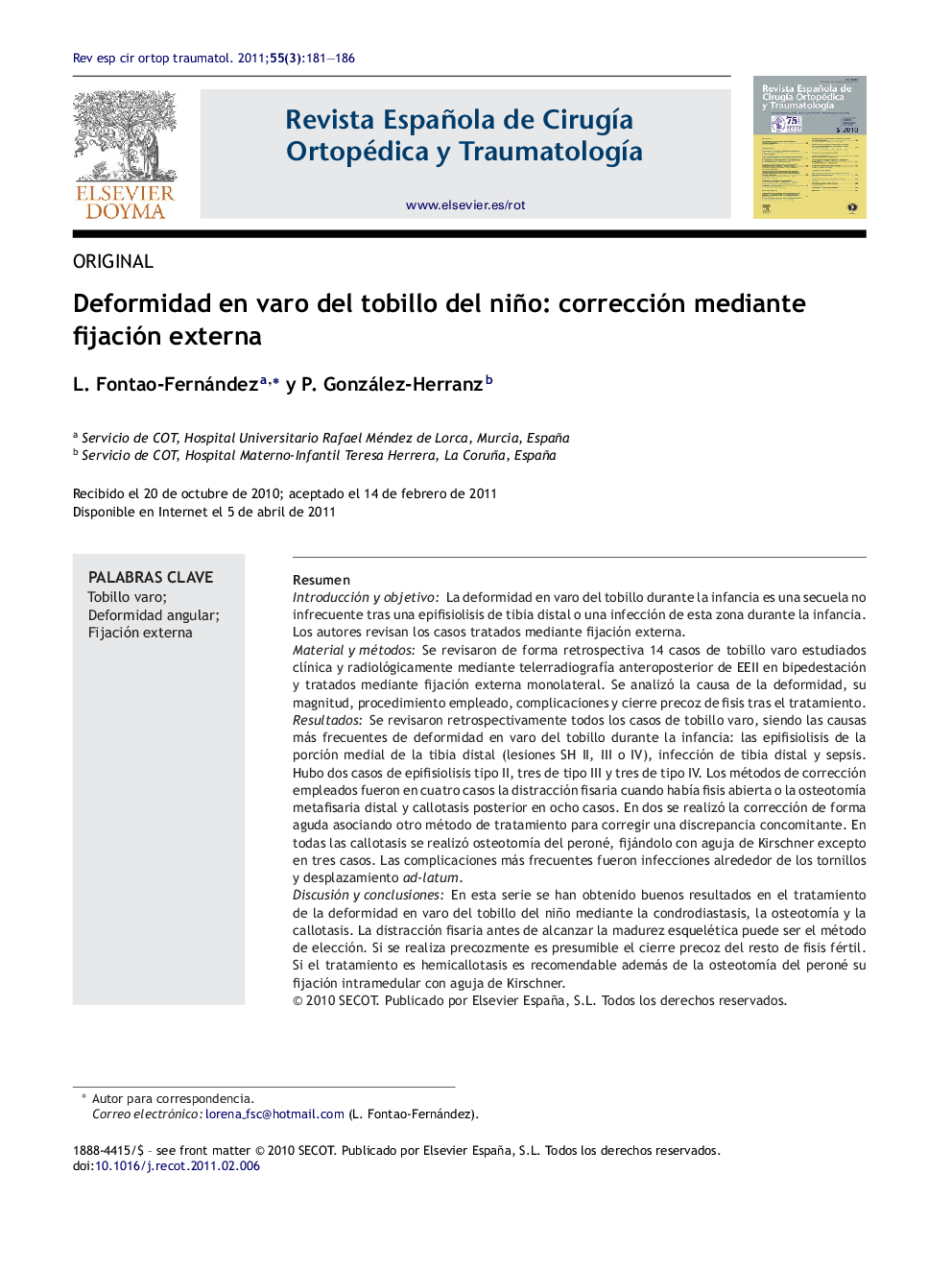| کد مقاله | کد نشریه | سال انتشار | مقاله انگلیسی | نسخه تمام متن |
|---|---|---|---|---|
| 4086679 | 1267968 | 2011 | 6 صفحه PDF | دانلود رایگان |

ResumenIntroducción y objetivoLa deformidad en varo del tobillo durante la infancia es una secuela no infrecuente tras una epifisiolisis de tibia distal o una infección de esta zona durante la infancia. Los autores revisan los casos tratados mediante fijación externa.Material y métodosSe revisaron de forma retrospectiva 14 casos de tobillo varo estudiados clínica y radiológicamente mediante telerradiografía anteroposterior de EEII en bipedestación y tratados mediante fijación externa monolateral. Se analizó la causa de la deformidad, su magnitud, procedimiento empleado, complicaciones y cierre precoz de fisis tras el tratamiento.ResultadosSe revisaron retrospectivamente todos los casos de tobillo varo, siendo las causas más frecuentes de deformidad en varo del tobillo durante la infancia: las epifisiolisis de la porción medial de la tibia distal (lesiones SH II, III o IV), infección de tibia distal y sepsis. Hubo dos casos de epifisiolisis tipo II, tres de tipo III y tres de tipo IV. Los métodos de corrección empleados fueron en cuatro casos la distracción fisaria cuando había fisis abierta o la osteotomía metafisaria distal y callotasis posterior en ocho casos. En dos se realizó la corrección de forma aguda asociando otro método de tratamiento para corregir una discrepancia concomitante. En todas las callotasis se realizó osteotomía del peroné, fijándolo con aguja de Kirschner excepto en tres casos. Las complicaciones más frecuentes fueron infecciones alrededor de los tornillos y desplazamiento ad-latum.Discusión y conclusionesEn esta serie se han obtenido buenos resultados en el tratamiento de la deformidad en varo del tobillo del niño mediante la condrodiastasis, la osteotomía y la callotasis. La distracción fisaria antes de alcanzar la madurez esquelética puede ser el método de elección. Si se realiza precozmente es presumible el cierre precoz del resto de fisis fértil. Si el tratamiento es hemicallotasis es recomendable además de la osteotomía del peroné su fijación intramedular con aguja de Kirschner.
Introduction and objectiveVarus deformity of the ankle during infancy is a not uncommon after effect after epiphysiolysis of the distal tibial or an infection in this area during childhood. The authors review the cases treated using external fixation.Material and methodsA retrospective review was made of 14 cases of varus ankle clinically and radiologically studied using lower limb antero-posterior teleradiography in the standing position and treated using monolateral external fixation. The cause of the deformity, its magnitude, procedure employed, complications, and premature physeal closure after treatment.ResultsAll cases of varus ankle were retrospectively reviewed, with the most frequent cause of the deformity in ankle varus during infancy being epiphysiolysis of the middle portion of the distal tibia (SH II, III or IV lesions), distal tibia infection or sepsis. There were two cases of epiphysiolysis type II, three of type III, and three of type IV. The methods of correction employed were, physeal distraction when the physis was open in four cases, and distal metaphyseal osteotomy and subsequent callus distraction in eight cases. In two cases correction was performed acutely combining another treatment method to correct a concomitant discrepancy. The callotasis was performed on all of them using fibular osteotomy, fixing it with a Kirschner wire, except in three cases. The most frequent complications were infections around the screws and ad-latum displacement.Discussion and conclusionsGood results have been obtained in this series of varus deformity of the ankle in the child by means of physeal distraction, osteotomy and callotasis. Physeal distraction before reaching skeletal maturity may be the method of choice. If it is performed earlier the premature closure of the rest of the fertile physis is likely. If the treatment is hemicallotasis, besides the fibular osteotomy, intramedullary fixation with a Kirschner wire is also recommended.
Journal: Revista Española de Cirugía Ortopédica y Traumatología - Volume 55, Issue 3, May–June 2011, Pages 181–186